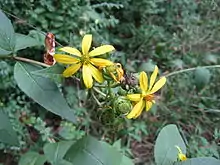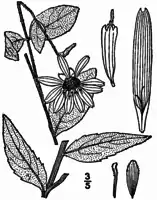Silphium asteriscus
Silphium asteriscus, commonly called starry rosinweed,[2] is an herbaceous plant in the aster family. It is native to the eastern United States, from Oklahoma and Texas east to Florida and Pennsylvania.[3] It is a widespread species found in a variety of open habitats, such as prairies and woodlands.[4]
| Silphium asteriscus | |
|---|---|
 | |
| Silphium.asteriscus var. asteriscus | |
| Scientific classification | |
| Kingdom: | Plantae |
| Clade: | Tracheophytes |
| Clade: | Angiosperms |
| Clade: | Eudicots |
| Clade: | Asterids |
| Order: | Asterales |
| Family: | Asteraceae |
| Genus: | Silphium |
| Species: | S. asteriscus |
| Binomial name | |
| Silphium asteriscus | |
Taxonomy
Additional research is needed to better understand the taxonomy of this species. It remains perhaps the most poorly-understood Silphium in eastern North America.[5] It appears to show a high level of local variability throughout its range. This has historically been interpreted as a species complex, although recent treatments have often reduced these to variety rank, with some exceptions. Many specimens appear as intermediate or hybrids, which complicates study. Due to conflicting information about the best circumscription of the varieties, the taxonomy of this species remains unsettled.[6][7]
A 2015 treatment elevated Silphium gatesii, Silphium glabrum and Silphium trifoliatum from variety to species status.[5] If adopted, this leaves S. asteriscus with three remaining varieties. They are:
- S. asteriscus var. asteriscus - Widespread in the southeast; with eglandular pales, and withering basal leaves
- S. asteriscus var. dentatum - Southeastern; with glandular pales, and withering basal leaves
- S. asteriscus var. simpsonii - Restricted to the southeastern coastal plain; with prominent basal leaves at flowering time[7]
 Line drawing of Silphium asteriscus
Line drawing of Silphium asteriscus
References
- "Silphium". Index Nominum Genericorum. International Association for Plant Taxonomy. 9 February 1996. Retrieved 24 June 2008.
- "Silphium asteriscus". Natural Resources Conservation Service PLANTS Database. USDA. Retrieved 18 January 2017.
- "Silphium asteriscus". County-level distribution map from the North American Plant Atlas (NAPA). Biota of North America Program (BONAP). 2014. Retrieved 18 January 2017.
- Flora of North America
- Chester, Edward (2015). Guide to the Vascular Plants of Tennessee.
- Flora of Missouri
- "Flora of the Southern and Mid-Atlantic States".
| Wikimedia Commons has media related to Silphium asteriscus. |
External links
 Data related to Silphium asteriscus at Wikispecies
Data related to Silphium asteriscus at Wikispecies